A colder than average winter in Europe, a summer without wind and a war in mainland Europe have massively increased demand for energy. In the UK, soaring demand for electricity and gas has led to the average domestic utility bill increasing by 54 percent.
The global energy crisis has been particularly damaging for residential care homes which need to spend much more on gas and electricity to keep elderly and vulnerable service users warm. As a result of the shortage, many have seen bills double. So, what does that exactly mean? Well, an average care home, which supports 50 service users, could see bills rise from £50,000 to £100,000. For those not locked into long contracts where the price of energy is capped, the cost could be even higher.
With the social care sector already grappling with a raft of economic challenges including recruitment, retention, reduced occupancy rates and higher insurance premiums, a significant hike in energy costs could be enough to send some care homes out of business.
So, what can care operators do to reduce their bills? It is a question that Quality Compliance Systems (QCS) the leading provider of content, guidance and standards for the social care sector, has consistently been asked by many of its customers.
Who better to ask than Christoph Marr, the founder of Marr Procurement, who has forged a close working relationship with the National Care Forum (NCF), a key partner of QCS?
Having worked for Care UK for a number of years, there is very little that Mr Marr, doesn’t know about care sector procurement or energy for that matter. His company, which he founded in 2015, currently advises 51 health and care providers, including several large clients in the care sector, helping them to deliver sizeable savings without compromising on quality.
So, what advice does Mr Marr have for care home managers who want to take decisive action to insulate their businesses from soaring energy prices?
Know the difference between the demand and supply side
Mr Marr says that care operators must be able to differentiate between the demand and supply. “It is absolutely essential for care managers or those in procurement to be able to separate demand from supply. The demand side is simply being in control, monitoring and reducing energy consumption in the home, while the supply side is the cost, (eg. the pence per kilowatt hour) of electricity or gas contract that a care provider signs up to.”
Demand side: how to stay in control
The most obvious way to reduce energy consumption is to turn the thermostats down by a degree or two. But in a care home it is often not possible, as vulnerable residents require the heating to be switched on all year round.
However, that doesn’t mean that care homes “cannot monitor and control temperatures more effectively” says Mr Marr. “We tell our clients, who operate single and multiple-sites, that the first step is to understand each location’s energy consumption. By building a real-time picture of energy consumption, directors can compare and contrast energy use for different locales. If one residential care home is much more energy efficient than other sites, directors can then visit the site and learn important lessons, which they can then apply to other care homes in the group.”
Energy conservation
Once a care home or group of homes can track energy use in real-time, “the next step” says Mr Marr “is to have mechanisms or a set of mechanisms to control it”. Mr Marr recommends that care homes explore the possibility of, for example, insulating their homes, installing energy efficient windows, switching off appliances and fitting low energy light bulbs.
However, he says, most important ‘is to build a business case for each energy improvement measure. “It’s no good simply putting in energy efficient glazing on a whim. Homes need to carefully evaluate the cost of each investment, the return on investment for each one and the energy saving benefits for the home.” By carefully assessing each green improvement, Mr Marr says that not only do directors “begin to understand the myriad of different measures” that can be taken to reduce consumption, “they can prioritise which ones to plump for first”. He concludes that the energy conservation steps that guarantee the quickest return on investment “are the one that directors should target first”.
Behaviour
Mr Marr says that at ground level, directors “need to create a culture of energy conservation in their care homes”. But he concedes that “taking such steps can be difficult” as the primary role of a care worker is to provide outstanding person-centred care for the service users they support. So, how therefore, do care homes go about instilling such a culture in their services?
Mr Marr, who has worked with large care homes for 14 years, believes that care homes have an advantage over other sectors in this respect. He notes, “There is a strong and healthy devolved culture of leadership in care homes. That is not to say that there isn’t central involvement, but a lot of autonomy is given to staff. This means that frontline staff are likely to be a lot more receptive in embracing new ideas and implementing them”.
Mr Marr says that managers have a key role too to “educate staff and encourage them to take ownership of energy use”.
He explains, “Ultimately, it’s about creating a network of energy champions and giving them a clear set of objectives. We did this at Care UK. We empowered champions to take responsibility for conserving energy, and it worked. We asked them to think about whether lights in rooms, which weren’t being used, needed to be on? Did computer screens, printers or mobile phone chargers need to be switched on 24/7? The champions began consciously asking these questions of themselves and their colleagues. Before long, the energy saving message had subconsciously manifested itself in the minds of staff and they began to conserve energy without even thinking.”
Supply Side – how to get it right
Every care home manager, director or procurement advisor reading this article will either be ‘inside’ or ‘outside’ some form of a fixed-term or flexible gas and electricity contract, which is often one of the most robust and binding agreements that a care provider can enter into.
“The temptation,” says Mr Marr “is to think that procurement is the only weapon that managers have in their armoury. For example, when providers buy gas and electricity, they do so at a certain price for a certain amount of time. It’s vital that they understand the market both now and at least have a sense for the near term. Intelligence, therefore, is actually the most valuable tool that providers have to ensure they stay in control of energy prices, as best they can.”
So, how do providers gain expert insight to make the best decisions? Mr Marr recommends that care homes take two steps. “Firstly,” he says, “Care providers should appoint a broker, who has an in-depth understanding of energy procurement, markets and how contracts are organised. Secondly, a care home should appoint an internal member of staff as an energy champion.”
But, why do care homes need to utilise the services of a broker? Says Mr Marr, “In short, care staff are there to provide extraordinary care. They tend not to be, (nor to most want to be), experts in wholesale energy markets, which are extremely complex and arcane. Those care providers that don’t employ a broker and have no in-house energy procurement capability, are more likely to be the ones that reach the end of their contract only to find that the energy price has dramatically increased and the next contract has risen sharply compared with the cost of the previous one.”
“So, it makes sense to bring in an expert,” continues Mr Marr, “but to also have an internal member of staff, who can sit in on monthly meetings and gain some comprehension of the market. That way, when it comes to making difficult decisions, the home’s energy champion will be informed enough to understand the broker’s recommendation and explain to senior directors why they should follow the advice given.”
Mr Marr says that it is this tripartite relationship of care home director, energy champion and broker that gives care providers the chance of securing the best deal. He explains, “An industry-leading brokerage will track the price of energy in real-time. It will plot the price of gas and electricity on graphs. By looking at current prices and weighing up future projections it can give providers a good indication of the pros and cons of placing at any given time so they are better informed when it comes to renewing their contracts.”
How do you find a reputable broker?
It’s a question that QCS customers often ask and Mr Marr has the following advice. “It is a bit of a conundrum,” he begins. “With the energy market heavily regulated by OFGEM, care providers could be forgiven for thinking that the same checks and balances have been applied to the energy brokerage market. Sadly, when it comes to energy brokers, they are not regulated, (eg. in the same way as energy providers are).”
Therefore, Mr Marr says that when searching for an excellent broker he advises his clients to seek at least two references from similar-sized care home providers and from the broker themselves.
Secondly, Mr Marr says that providers must check that brokers are wholly transparent as to how they make their money. “Care providers need to know the broker’s fee, and most importantly, how it is accumulated. “It is quite common for a broker fee to be part of the price that the client pays the energy provider. Technically, there is nothing wrong with this model, providing of course that the broker is one hundred percent transparent regarding its fee. Occasionally, you hear horror stories, where a care provider hasn’t done its due diligence and has paid the broker much more than it needed to.”
Thirdly, Mr Marr advises providers to ask a broker how many energy suppliers it will contact before recommending a deal. “A lazy broker will only seek quotes from a couple of energy companies, however, diligent and hardworking brokerages will have many suppliers that they can seek quotes from.”
Not only does a wider pool of utility suppliers mean more choice, it also guarantees a greater number of options for care providers.
Mr Marr explains, “This is exceptionally important. Why? Because the sum of money needed to fund an energy contract can be considerable, so energy providers will run a credit check on the care provider before agreeing to supply them energy. If the energy company believes that the care provider could be a risk, they may request a substantial deposit upfront before entering into any agreement. However, there are energy suppliers who may not necessarily require a deposit and that is why it pays to choose a broker with an extensive network of contacts.”
Finally, Mr Marr says that care operators should insist on brokers providing them with a bureau service and adds that they should “find out exactly what that entails” before signing a contract.
He explains, “Requesting a bureau service is pretty standard, but care providers should ensure that in addition to buying energy contracts, deciding on the type of agreement and how long it should be, ensuring it also includes a full audit service. This gives the provider peace of mind that it is being charged the correct amount for energy, not over paying on VAT and receiving concessions when they are due. A first-class bureau service will also provide the procurement manager with the insight and visibility that they need to forecast energy costs, which can then be relayed to the Chief Financial Officer and fed into the budget. Having such a service in place is the hallmark of a well-informed and highly organised care provider, which every care provider in the land can aspire to.”
The article is first published by Care Home Professional here
You can also find some top tips for supporting your team during this financially difficult climate below.
Read Here





